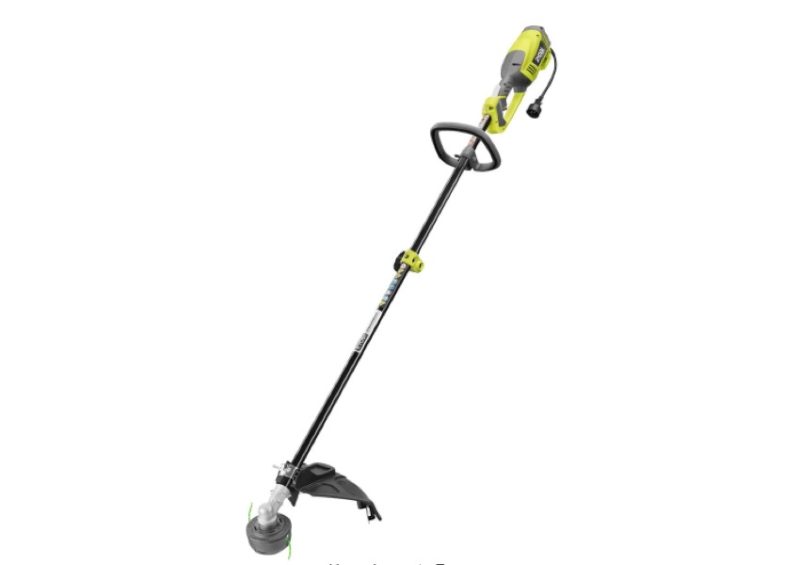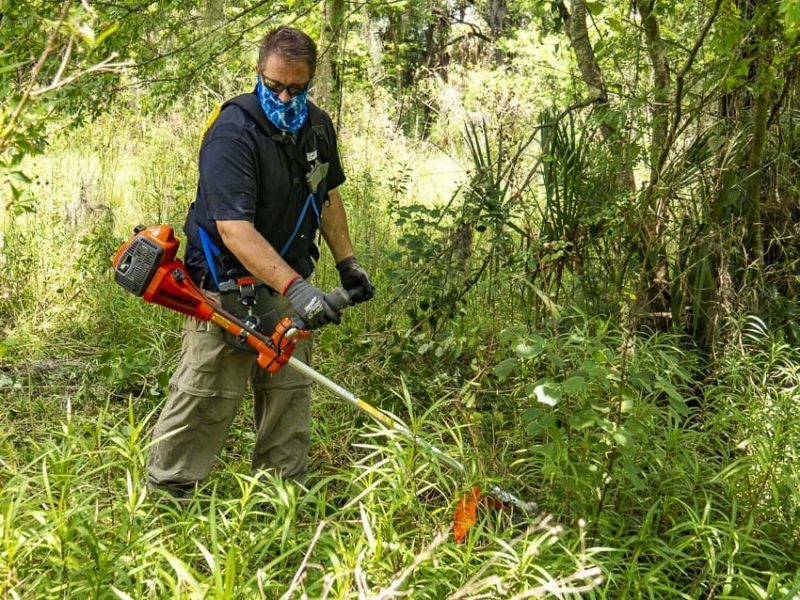
Whether you call it a weed eater, weed wacker, weed trimmer, or something else, string trimmers have the same fundamental concept—spin trimmer line fast enough for the tips to cut grass. Ask a random sampling of five people, and they’ll likely tell you five different models for the best string trimmer. We asked our not-so-random team to dive in and offer their recommendations for everything from homeowners with small lawns to professional lawn care crews.
Our Top Picks
Best String Trimmer Overall for Professionals
Echo X-Series String Trimmer SRM-2620T
There’s a ton of debate about the best gas string trimmer overall, and Echo consistently shows up in it with their X-Series SRM-2620/2620T model. The only difference between the two is the “T” model has 2:1 high-torque gearing, and we generally recommend that one for professional use.
This model balances all things well. The 25.4cc engine keeps the weight reasonable (12.5 pounds dry) and is consistently easy to start. In terms of power-to-weight ratio, the 2620T is as good as it gets. Holding just under 21 ounces of fuel, it has solid runtime. It’s also highly maneuverable and the narrow guard gives you great sightlines on the 17-inch cutting swath. As an added bonus, the Speed-Feed 400 head makes line changes simple.
Price: $389.99 ($359.99 for the 2620)
Best String Trimmer Overall for Homeowners
EGO PowerLoad String Trimmer with Line IQ ST1623T

For homeowners, it’s a pretty easy call to make the switch to a battery-powered system if it’s in your budget. EGO consistently puts out some of the top-performing and lowest-vibration string trimmers on the market.
Better yet, they tend to lead in technology development and have pushed the bar forward once again with the ST1623T. It features PowerLoad—a technology that lets you load line easier than ever. Just thread your new line to the halfway point in the head, press the PowerLoad button, and it automatically winds.
There’s also line IQ. This is an automatic feeding system that keeps your line at 16 inches without having to bump the head as you go along. Throw in a telescoping carbon fiber shaft and it’s pretty easy to see why it’s our choice as the best string trimmer for homeowners.
Price: $197 bare, $299 with 4.0Ah battery and charger
Best Gas String String Trimmer
Stihl Professional String Trimmer FS 91 R

Echo’s 2620T was our pick for the best overall professional string trimmer, and as a gas model, it’s obviously the best gas string trimmer in our book as well. Not far behind is Stihl’s workhorse—the FS91. This 16.5-inch trimmer’s 28cc engine has plenty of power for trimming lawn grasses and even sees some farm and ranch work. At the same time, its 12.1-pound dry weight is easy to manage and its 24-ounce fuel tank offers impressive trigger time between fill-ups.
Of course, Stihl’s extensive dealer and service network is a major plus of owning its products. When you need regular maintenance or on the off chance your trimmer unexpectedly needs a repair, you can get it back in the game quickly.
Price: $359.99
Husqvarna 520iLX Battery-Powered String Trimmer

Built for professional and large property use, Husqvarna’s 520iLX is a cordless battery-powered string trimmer that should be on your radar. Its performance is right on for hitting lawn grasses and we like the reverse direction button to release tangled grass.
It’s other characteristics that set it apart, though. The bare trimmer weighs just 6.6 pounds and adding a battery keeps it well under the 10-pound mark. It’s one of the lightest, most well-balanced trimmers you can get with a professional build.
From there, it has extremely low vibration and while the noise level isn’t the lowest we’ve tested, its tone is far less irritating than other models.
Husqvarna does have a 525iLX model that’s a bit higher up the food chain, but the 520 is $100 less and for that price, we’ll keep running it until we can’t anymore.
Price: $299.99 bare tool, $749.99 kit
Best Electric String Trimmer
Ryobi Attachment Capable Electric String Trimmer RY41135

Just because you prefer plugging in for power doesn’t mean you have to settle for low performance. In a close decision, Ryobi edges out Kobalt in a battle of 10-amp, 18-inch options. In addition to the same power and cutting swath, both trimmers are also attachment capable and reasonably low weight. What pushes Ryobi into the win column as the best electric string trimmer is its easy load head that makes one of the most frustrating parts of owning a string trimmer easier to deal with.
Price: $89.97
Best String Trimmer for Large Areas
Echo X-Series Brushcutter SRM-2620U

The best string trimmer for large areas where mowers can’t go has to meet several qualifications: it has to have excellent runtime, a large cutting swath, and (in our opinion) needs to be a bike handle design.
Take our top overall professional pick, add a bike handle and harness, and you get the Echo SRM-2620U brushcutter. It has the same engine and trimmer head but swaps a D-handle for the greater support that a bike handle design offers while giving you the same performance with a design that’s much easier to manage for longer periods of time.
Price: $419.99
Best String Trimmer for Overgrown Areas
Husqvarna Brush Cutter 545FR

If you’re dealing with a lot of overgrowth, be prepared to take your time. In this scenario, we recommend a bike handle string trimmer that’s capable of using a brushcutter head when the going gets really tough. We also recommend going with a bigger engine.
When you need a brushcutter that doesn’t know when to quit, our top choice as the best string trimmer for overgrowth is the Husqvarna 545FR. It has a powerful 45.7cc engine that is happy using a trimmer head, grass blade, or brush cutting blade. From tall grass to saplings, it’s an efficient way to clear areas in a hurry. Toss in a comfortable harness, vibration-dampening bike handles, and easy starting, and this is an easy recommendation for us to make.
Price: $949.99
Best String Trimmer Line
Echo Black Diamond String Trimmer Line

There’s no question I’m going to start an argument in this section (even within our own office), but the best string trimmer line is Echo’s Black Diamond line. It’s denser than many of the basic lines out there, combining with a sharp-pointed square twist to make it more effective at cutting for its size. Available in 0.095-inch and 0.105-inch sizes, it’s great for almost any trimmer and it’s a fantastic choice for battery-powered options.
Best String Trimmer Brand

If the last section started an argument, this one is going to start an all-out brawl. When it comes to covering the entire scope of string trimmers, Echo, Husqvarna, and Stihl are all consistently part of the conversation with other brands such as Makita and Redmax also showing up. Toss in all-battery brands such as Milwaukee and Greenworks Commercial and the landscape can be confusing.
In our opinion, Husqvarna is the best overall string trimmer brand. They have a wide range that covers homeowners through professionals, gas and battery, and lawn cutting through forestry brush cutting better than anyone else. While Stihl sets the standard for servicing dealer networks, Husqvarna does a fine job of showing up close to home as well.
Best String Trimmer Buying Guide – What We Look For
Gas Vs Battery Vs Electric String Trimmers
Choosing your string trimmer power source has a lot to do with balancing performance, convenience, and price.
Gas offers the most power and when you run out of fuel, a fill-up only takes a few minutes. On the other hand, they’re loud, require maintenance, need an oil and gas mix, and produce emissions.
Battery-powered string trimmers have lower noise, no emissions, and very little maintenance. Plus, today’s performance can match a 30cc engine with roughly the same runtime as a tank of gas. However, cordless string trimmers can be more expensive, and charging a battery can take several hours in some cases.
Electric string trimmers have the benefits of battery-powered ones with the added bonuses of costing less and having near-infinite runtime. They typically don’t reach as high on the power scales, though, and you’re stuck dragging an extension cord all over your lawn.
String Trimmer Line Size
Most string trimmers are rated for somewhere between 0.080 and 0.105-inch line with fringe options below and above that range (one string trimmer even uses zip ties, but we don’t recommend it).
Generally speaking, smaller diameter line doesn’t do as much damage to objects it hits, such as the paint on your exterior walls, wood on your pergola, or irrigation pipes. It also gets the most runtime out of battery-powered string trimmers. As you go up in diameter, the line becomes more destructive and less energy efficient, while holding up better in tough conditions.
For smaller lawns, 0.080-inch line is great for keeping your grass under control, has excellent runtime for battery-powered string trimmers, and lets you put more line on the head compared to larger diameters. This is the minimum line size we recommend in most cases.
0.095-inch line is a great all-around combination for quick cutting, moderate risk of collateral damage, and solid runtime for cordless trimmers. For most cordless string trimmers, this is as thick as we recommend going, though some Pro models are fine moving up a step.
For professional crews, farm and ranch, and other large properties, 0.105-inch line is the way to go. It quickly clears overgrowth and grasses with thicker stalks while holding up to a lot of abuse. It takes more energy to spin the extra mass, though, and you likely need a 30cc+ engine to make the most effective use of it. If you’re considering battery-powered options, we only recommend 0.105-inch line for high-end professional models specifically designed to handle it.
Cutting Swath
Cutting swath is the diameter your line covers. For smaller lawns, 13 – 14-inch is fine, especially when you’re using a walk-behind mower that can get closer to landscape edges. 15 – 16-inch is a good all-around diameter while professional crews and large property owners get the most out of 17-inches or more.
Weight
String trimmer weight is a big consideration. The more weight is out on the end, the more your back has to work to help you work with it. Shoulder straps help tremendously, especially for the largest gas units and some cordless models come with one as well.
In most cases, pick the lightest string trimmer that has the performance for your toughest jobs with the build quality that will last you many years.
Vibration
Vibration came into center focus with high-performance cordless string trimmers. All gas engines have at least some vibration, and most people didn’t think much of it. That’s still the case for gas, but cordless and electric string trimmers vary widely in how much vibration they create. In many cases, shifting the motor to the head helps reduce the vibration of a drive shaft, even though it moves some of the weight away from your arms.
Features
For the most part, there aren’t a ton of extra features to look for on gas and AC electric string trimmers. However, brushless battery-powered models can have a few that can swing your purchase decision one way or the other. Here are some to keep an eye on:
- Attachment capability (all power types)
- Multiple speeds (including automatic modes)
- Reverse rotation to untangle tall grass
- Faster throttle up
- Compatibility with other lawn care equipment and power tools
Value
We’re big on value—getting the most bang for our buck is always high on our list. It’s not just about what the cheapest string trimmer you can get is. It’s about meeting your top priorities and coming in under budget.
Ever check out a “review” site and you can’t tell if they actually tested the tools or if they’re just “recommending” the Amazon top sellers? That’s not us. We won’t recommend anything unless we’d actually use it ourselves and we don’t really care who the primary retailer is. It’s all about giving you a legitimate recommendation and our honest opinion of each product.
We’ve been in business since 2008 covering tools, writing reviews, and reporting on industry news in the construction, automotive, and lawn care industries. Our Pro reviewers work in the trades and have the skills and experience to know whether tools can perform well in the field.
Each year, we bring in and review more than 250 individual products. Our team will put our hands on hundreds of additional tools at media events and trade shows throughout the year.
We consult with innovators in the technology and design of tools to gain a broader grasp of where these products fit and how they work.
We work with more than two dozen professional contractors around the United States who review products for us on real job sites and consult with us on testing methods, categories, and weighting.
We’ll provide more than 500 pieces of new content this year absolutely free for our readers—including objective evaluations of individual tools and products.
The end result is information you can trust because of the editorial, scientific, and real-world professional experience we collectively utilize each and every time we pick up and test a tool.






